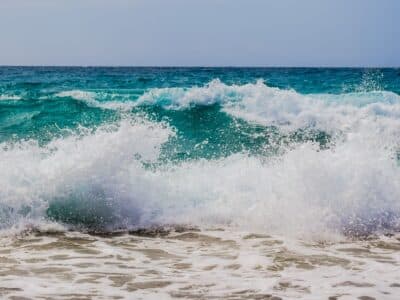Are you ready to capture the awe-inspiring beauty of the ocean through your lens?
Everyone takes pictures at the beach, but few people can take truly incredible photos. So, you might be wondering: how do you take good pictures of the ocean?
As a passionate digital photographer (and someone who spends a lot of time at the beach), I’m thrilled to share my tips on how to take stunning ocean images.
Whether you’re a beginner or looking to enhance your ocean photography skills, these four essential tips will help you make waves with your ocean captures.
4 Tips for Ocean Photography
Be prepared for the weather
One of the first things to understand about ocean photography is that the weather can be unpredictable. Be ready for changing conditions, including gusty winds and saltwater spray.
Invest in a sturdy camera bag or cover to protect your gear. It’s always a good idea to dress appropriately depending on where you are in the world and the time of year. Bring sunscreen for those long, sunny, hot beach days. Wear warm winter gear and waterproof boots in colder climates.
Also, pay attention to the tide schedule. Not only will this enable you to take the shots you want, but it will keep you safe as well.
Bring the equipment you need
When heading out for a day of ocean photography, ensure you have the right equipment:
- Wide Angle Lens: Ideal for capturing vast ocean landscapes, a wide-angle lens allows you to encompass more of the scene in your frame.
- Telephoto Lens: A zoom lens can help you get closer to distant subjects like surfers or birds.
- Neutral Density (ND) Filters: These filters help achieve longer shutter speeds for capturing motion in the waves or creating long exposures.
- Tripod: A sturdy tripod is a must for stable shots, especially during long exposures.
Use the right camera settings
To make your ocean images pop, consider these camera settings:
- Shutter Speed: For capturing the motion of the waves, try using longer shutter speeds (slow shutter speed). This blurs the water, creating a sense of motion and fluidity.
- Aperture: Use a smaller aperture (higher f-number) for greater depth of field in landscape photography.
- ISO: Keep your ISO as low as possible to maintain image quality.
- Focus: Ensure your subject is in focus, whether it’s a crashing wave or a distant sailboat.
Find good lighting
Lighting conditions can make or break an ocean image. Aim to shoot during the golden hours—sunrise and sunset—when the soft, warm light enhances the colors and textures of the ocean. Pay attention to the angle of the sun to prevent harsh shadows.




Leave a Reply